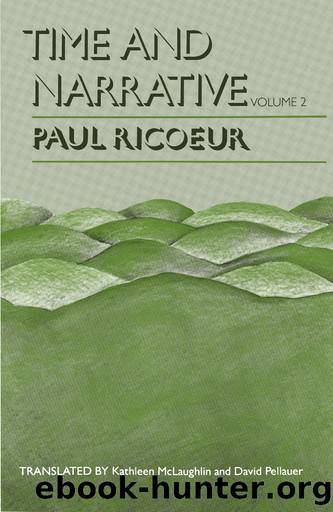Time and Narrative, Volume 2 by Paul Ricoeur

Author:Paul Ricoeur [Ricoeur, Paul]
Language: eng
Format: epub
ISBN: 9780226713526
Publisher: University of Chicago Press
Published: 1985-09-15T05:00:00+00:00
Conclusion
At the end of this second volume of my study of time and narrative, I should like to make an overall assessment as I did at the end of volume 1 (pp. 226â30).
The first conclusion to be drawn concerns the narrative model worked out in Part I of Time and Narrative under the title of âthreefold mimesis.â The study you have just read has claimed to remain strictly within the limits of mimesis2, that is, within the confines of the mimetic relation that Aristotle identified with the rule-governed composition of a tale. Have I truly remained faithful to this important equation between mimesis and muthos?
I should like openly to express certain scruples that have been continually present throughout the writing of this volume.
The one that is easiest to formulate finds its answer in Aristotleâs Poetics. Does not my use of the substantive ânarrative,â the adjective form ânarrative,â and the verb âto narrateâ (or sometimes in English, âto recount,â âto tellâ), which I hold to be rigorously interchangeable, suffer from a serious equivocation, to the extent that these terms seem to cover at times the entire field of the mimesis of action, and at times just the diegetic mode, to the exclusion of the dramatic one? What is more, due to this equivocation, do we not find that I have surreptitiously transferred to the diegetic mode categories specific to the dramatic one?
The right to use the term ânarrativeâ in a generic sense, while respecting in appropriate contexts the specific difference between the diegetic and the dramatic modes, appears to me to be founded in the very choice of the notion of a mimesis of action as my dominant category. Actually, muthos, from which my notion of emplotment is derived, is a category possessing the same scope as the mimesis of action. The result of this choice is that the distinction between the diegetic mode and the dramatic mode moves to the background. It answers the question of the âhowâ of mimesis and not the question of its âwhat.â It is for this reason that examples of well-constructed plots may be drawn indifferently from Homer or from Sophocles.
The same scruple reappears, however, in another form when one looks at the order of my four chapters in this volume. One may no doubt grant that by broadening and deepening the notion of plot, as I announced in introducing the first two chapters of this volume, I confirmed and strengthened the priority of the generic sense of fictional narrative in relation to the specific sense of the diegetic mode. On the other hand, I might be reproached with having gradually confined my analyses to the diegetic mode by dealing in games with time. The distinction between utterance and statement, then the stress placed on the dialectic between the narratorâs discourse and that of the character, and finally the fact that I concentrate at the end on point of view and narrative voiceâdo not all these aspects indicate a preference for the diegetic mode? Foreseeing
Download
This site does not store any files on its server. We only index and link to content provided by other sites. Please contact the content providers to delete copyright contents if any and email us, we'll remove relevant links or contents immediately.
4 3 2 1: A Novel by Paul Auster(12281)
The handmaid's tale by Margaret Atwood(7678)
Giovanni's Room by James Baldwin(7188)
Asking the Right Questions: A Guide to Critical Thinking by M. Neil Browne & Stuart M. Keeley(5631)
Big Magic: Creative Living Beyond Fear by Elizabeth Gilbert(5610)
Ego Is the Enemy by Ryan Holiday(5292)
The Body: A Guide for Occupants by Bill Bryson(4973)
On Writing A Memoir of the Craft by Stephen King(4863)
Ken Follett - World without end by Ken Follett(4643)
Adulting by Kelly Williams Brown(4485)
Bluets by Maggie Nelson(4472)
Eat That Frog! by Brian Tracy(4430)
Guilty Pleasures by Laurell K Hamilton(4358)
The Poetry of Pablo Neruda by Pablo Neruda(4038)
Alive: The Story of the Andes Survivors by Piers Paul Read(3967)
White Noise - A Novel by Don DeLillo(3953)
Fingerprints of the Gods by Graham Hancock(3938)
The Book of Joy by Dalai Lama(3897)
The Bookshop by Penelope Fitzgerald(3775)
